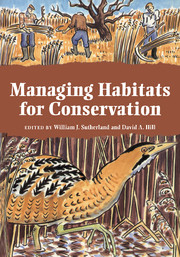Book contents
- Frontmatter
- Contents
- List of Contributors
- Acknowledgements
- 1 Introduction and principles of ecological management
- 2 Site management planning
- 3 Access
- 4 Coastal habitats
- 5 Rivers, canals and dykes
- 6 Waterbodies
- 7 Reedbeds, fens and acid bogs
- 8 Grasslands
- 9 Farmland
- 10 Lowland heathland
- 11 Upland moors and heaths
- 12 Woodland and scrub
- 13 Urban areas
- Some useful addresses
- Index of species by common names
- Subject index
1 - Introduction and principles of ecological management
Published online by Cambridge University Press: 05 February 2015
- Frontmatter
- Contents
- List of Contributors
- Acknowledgements
- 1 Introduction and principles of ecological management
- 2 Site management planning
- 3 Access
- 4 Coastal habitats
- 5 Rivers, canals and dykes
- 6 Waterbodies
- 7 Reedbeds, fens and acid bogs
- 8 Grasslands
- 9 Farmland
- 10 Lowland heathland
- 11 Upland moors and heaths
- 12 Woodland and scrub
- 13 Urban areas
- Some useful addresses
- Index of species by common names
- Subject index
Summary
Introduction
This book was born out of the frustration caused by the lack of readily accessible information on habitat management. Our aim in this book is to collate the available information to produce a practical guide to what needs to be done rather than exactly how to do it. Thus, for example, we will describe the conditions in which coppicing or building a boardwalk is a good idea but not actually how to coppice or construct a boardwalk. (A good source for advice on such techniques is the British Trust for Conservation Volunteers; see end of book for address.) The authors of each chapter were asked to imagine someone who has become responsible for managing an area and to provide the sort of information that that person would require to make the necessary management decisions. This book is directed towards conservationists in the United Kingdom but we expect it will be of relevance elsewhere, particularly in Western Europe. After the chapters on the general issues of planning and access, each chapter describes a different habitat. Most sites will include many habitats, for example, a wetland site may include open water, fen, reeds, woods and heaths and could even be an urban site.
The need for such a book is clear from the fact that we have seen the rapid local extinction of numerous species not only due to direct habitat loss, persecution and pollution but also from habitat deterioration through lack of appropriate management. Butterflies are particularly sensitive and many species have shown dramatic declines. For example, High Brown Fritillary Argynnis adippe has disappeared from 94% of its previous locations, the Heath Fritillary Mellicta athalia from 92% and the Marsh Fritillary Euphydryas aurinia from about 63%. Thomas (1991) points out that a number of explanations have been put forward for such extinctions including over-collecting, insecticides, habitat fragmentation, climatic cooling and, nowadays, air pollution.
- Type
- Chapter
- Information
- Managing Habitats for Conservation , pp. 1 - 21Publisher: Cambridge University PressPrint publication year: 1995
- 4
- Cited by

